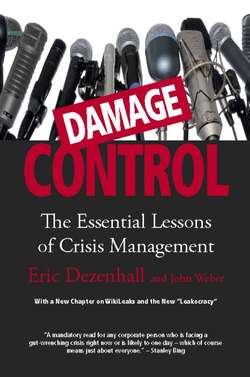Читать книгу Damage Control (Revised & Updated) - Eric Dezenhall - Страница 11
На сайте Литреса книга снята с продажи.
ОглавлениеCHAPTER 1
The Tylenol Case Isn’t the Model for Every Crisis
What began as J&J’s darkest hour turned out to be its brightest in terms of corporate reputation.
—LARRY FOSTER, CORPORATE VICE-PRESIDENT OF PUBLIC RELATIONS DURING THE TYLENOL TRAGEDIES
We sometimes play a parlor game before meeting a prospective client: We take bets on how long it will take until someone associated with the client invokes the autumn 1982 Tylenol cyanide-tampering case as the model they’d like to see emulated in a proposed damage-control initiative. Bonus points are awarded in the event that someone at the table actually claims to have worked on the crisis, in which seven people—including three in one family—were killed when they took Tylenol laced with cyanide.
It’s not that Johnson & Johnson, Tylenol’s manufacturer, didn’t effectively handle the fallout from the homicides. It’s that the case study has been hyperapplied like a medieval elixir to situations that have little or nothing in common with the legendary crisis.
Just over a week after the cyanide deaths were first reported at the end of September 1982, J&J recalled and destroyed 31 million capsules at a cost of $100 million. The company’s chairman, James Burke, appeared in television ads and at news conferences informing consumers of the company’s actions. Tamper-resistant packaging was rapidly introduced within weeks of the murders, accompanied by a huge advertising campaign to demonstrate the new technology.
Everybody likes the Tylenol case because it involved a famous product and had a happy ending for the company. Academics use the model because it’s teachable and validates the ethic of social responsibility: that “acting responsibly” is always rewarded by the marketplace. Public relations people love the Tylenol case study because it suggests there is a proprietary technique—one that they happen to know—for resolving crises. This technique inevitably includes the merits of expressing concern for consumers (which should be obvious) and, more important, the supposed benefit of the “instant” product recall.
In the months following the crisis period, J&J officials gave speeches and interviews about the case, seeking—and receiving—communications industry awards. Shortly after the murders, chief executive Burke was interviewed by CBS’s 60 Minutes in an uncharacteristically laudatory segment for the confrontational news program. Tylenol sales swiftly bounced back to near precrisis levels even though the killer was never found. Given the damage the murders could have done to the brand, this result was—and remains—extraordinary.
There is much to learn from Johnson & Johnson’s crisis management, but blindly worshipping at this altar may be little more than an exercise in self-delusion for companies that find themselves in the crosshairs of an anxious public, a hostile media, and regulators under extraordinary pressure to make an example of bad industrial actors.
